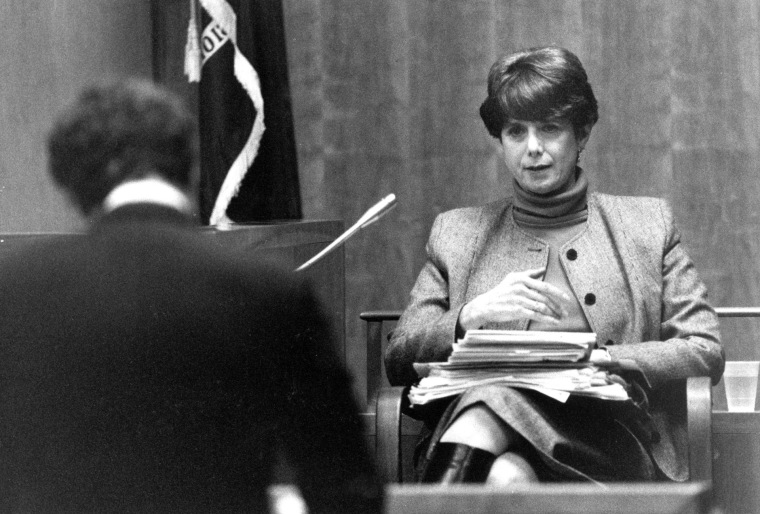Director Alex Gibney's HBO documentary "Crazy, Not Insane" threads the serial killer documentary needle between gruesome voyeurism and scientific inquiry by profiling Dr. Dorothy Otnow Lewis, whose theories about what makes a murderer are controversial to say the least.
Lewis' theory is that a perfect storm of human behavior creates the sort of murderer we think of as having been "born bad," rather than something supernatural or beyond comprehension. And, unfortunately, humans can be horribly violent to one another, and especially to the most vulnerable among us; when children become targets of human violence for long enough, well, that violence begets their eventual violence.
But the idea that there is such a simple cause and effect is seemingly too close to "excusing violent behavior" for those who favor the death penalty.
"Crazy, Not Insane" is the latest entry in a recent explosion of true crime documentaries; currently, Lifetime movies and Investigation Discovery shows vie for your brain space alongside more "serious" offerings from award-winning directors. And while, both there and in the adjacent true crime podcast space, it's easy to both write off serial killers as hideous monsters who deserve to rot and to indulge in some Old Testament thirst for vengeance, Gibney and his subject are less interested in what to do about them and more interested in how they got that way.
When children become targets of human violence for long enough, well, that violence begets their eventual violence.
At the beginning of the documentary, Lewis describes her fascination with Hitler and the Nuremberg trials after having grown up during World War II. She says she remembers thinking to herself that she was disappointed when Hitler died by suicide, because we'd never find out what made him tick.
Today, Lewis specializes in trauma and its link to violent crime; she has interviewed 22 serial killers and testified in numerous death penalty cases about her belief that, while the killers must be punished, they aren't competent to stand trial or be executed for their crimes.
The seeds of this theory were planted during her years working with kids and teens in juvenile facilities, including the Bellevue Children's Psychiatry Ward. There, she and Dr. Jonathan Pincus, a neurologist, discovered that their most disturbed patients had suffered horrifying physical and/or sexual abuse and that their brain scans revealed organic damage and dysfunction, often caused by that abuse.
Adding psychosis to that mix is what she believes creates serial killers.
Her inadvertent expertise came about when public defender Richard Burr saw her television interview with Diane Sawyer about her research into violence and children. Burr asked her to evaluate and testify in behalf of his client William Elledge, who was on death row for rape and murder.
Lewis has since become something of an expert in the field of the most harrowing crimes imaginable — as Gibney demonstrates with clips of her interviews with children and adults in psychiatric wards, as well as murderers like Arthur Shawcross, as they describe the abuse they suffered. Reading or hearing descriptions of abuse second- or thirdhand is different from watching someone describe their own, especially when they are actively disassociating while describing it. (It is some of the most upsetting footage of real events I've ever seen.)
Lewis' theories simultaneously demystify serial killers and somehow make them more horrifying, because now they're simply human.
Lewis and Dr. Catherine Yeager, her research assistant, explain that they didn't swallow these memories of abuse whole; they fact-checked the details through medical reports, interviews with family members and the like.
Dissociative identity disorder, or DID, formerly incorrectly known as multiple personality disorder, is another cornerstone of Lewis' studies. The larger controversies around DID — caused by cultural phenomena like the movie "Sybil" and the McMartin Preschool trials — aren't touched upon in Gibney's documentary, but it's hard not to wonder whether that (at least in part) contributes to Lewis' outsider status among legal experts and forensic psychiatrists.
Lewis' most famous interviewee was Ted Bundy; he personally asked to see her when he was on a confession spree to try to pre-empt his execution in 1989. "I was far more interested in how he got the way he was," she says.
When Lewis evaluated Bundy for a competency hearing in 1987, she diagnosed him with bipolar disorder; she now disagrees with that diagnosis. Instead, she attributes his vile impulses to extensive mental and physical abuse basically from his earliest moments on, as well as a family history of mental illness, all of which culminated in his psychosis and DID. (He fervently denied anything but a happy, well-adjusted childhood up until another interview with Lewis in 1989, and he even requested that she turn off her tape recorder at one point to share some details.)
For him and other serial killers like him, she believes, it felt less shameful to be thought of as sheer evil than to admit the abuse they'd suffered or the mental illnesses they lived with, if they were aware of it at all.
"Don't you ever wonder why you don't murder?" she asks Gibney, who replies off camera, "I do."
And that's the crux of her work: Anyone could become a murderer, given the right circumstances. The idea that someone like Ted Bundy was "born bad" is seductive — it's a myth Bundy created and encouraged, one that's lasted for decades — but Lewis' theories simultaneously demystify serial killers and somehow make them more horrifying, because now they're simply human.



